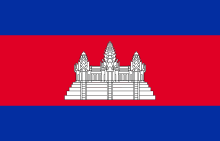Little Cambodia
| Little Cambodia | |
|---|---|
 Cambodian enclaves are made up mostly of refugees from the country of Cambodia since the 1980s. | |
| Khmer name | |
| Khmer | ក្រុងខ្មែរ UNGEGN: Krŏng Khmêr ALA-LC: Krung Khmaer IPA: [kroŋ kʰmae] |
Little Cambodia or Cambodia Town (Khmer: ក្រុងខ្មែរ) is a term that refers to an ethnic enclave of people from the country of Cambodia.
History
Cambodian presence in the West traces back to the
While some were able to flee to France shortly after the
Locations
United States
Bronx, New York
In
Chamblee, Georgia
Buford Highway near Atlanta, Georgia, nicknamed "Chambodia" for the city is named Chamblee, Georgia. This is a common misnomer as there are actually very few Khmer businesses in the Buford Highway area. It is predominantly Chinese, Vietnamese, and Mexican.[2]
Long Beach, California
Lowell, Massachusetts
- A business community in the Lower Highlands neighborhood of Lowell, Massachusetts[4]
Philadelphia, Pennsylvania
Philadelphia's Cambodia Town neighborhood is in South Philadelphia, which has long been home to many different groups of immigrants.[5] Exemplifying that, the broader neighborhood surrounding Philly's Cambodia Town is extremely diverse, having been cited as roughly a third white, a third African American and Latino, and a third Asian.[6] By 2010 census numbers, Philadelphia's Cambodia Town is the fourth largest Cambodia Town in the United States, trailing only Long Beach, Lowell, and Stockton.[7][8]
Its main commercial corridor is along S. 7th Street — and to some extent S. 6th and even S. 8th Streets — between Morris Street to the north and Oregon Avenue to the south, including Mifflin Square Park.[8][6] (Others have more narrowly defined the central aspect of this to between Snyder Avenue to the north and Porter Street to the south.[9]) The neighborhood contains extensive references to Cambodian and Khmer culture, including street and business signage as well as Cambodian temples that serve as spiritual and cultural centers.[10] Notably, the diaspora in the community contains, but is not limited to, people who identify as Khmer (ethnic Cambodians from Cambodia), ethnic Chinese from Cambodia, ethnic Cambodians from South Vietnam, and ethnic Vietnamese from Cambodia.[11]
Many Cambodian restaurants in the neighborhood, such as I Heart Cambodia, New Phnom Penh, Heng Seng, Sweet Basil Express, and Sophie's Kitchen, have been recognized in greater Philadelphia-area media for their outstanding food.
In addition to the many local Cambodian small businesses in Cambodia Town itself, the Southeast Asian Market in
San Francisco and Oakland
White Center, Washington
- White Center, a suburb of Seattle, has a significant Cambodian-American community (642 Cambodian-Americans; 4.8% of the city's population). There are several Cambodian grocery stores, and Cambodian New Year is celebrated in this city.[19][20]
France
Lognes
With Asians comprising over 40% of the city's population, the Parisian suburb of
References
- ^ New York Times. 20 January 2008.
- Washington Post.[dead link]
- ^ "Cambodia Town - Long Beach's Little Phnom Phen".
- ^ "City of Lowell Recognizes Cambodia Town". City of Lowell. Archived from the original on 19 December 2013. Retrieved 18 December 2013.
- ^ "South Philadelphia, Pennsylvania Population & Demographics".
- ^ a b Wilson, Jason (15 May 2019). "FOODIZEN: NOT CAMBODIA TOWN". The Philadelphia Citizen. Retrieved 25 February 2024.
- American FactFinder
- ^ a b c Manning, Joy (14 May 2015). "Carving an official Cambodia Town out of South Philadelphia". The Philadelphia Inquirer. Retrieved 25 February 2024.
- ^ a b Cicioni, Brian (25 August 2016). "EXPLORING PHILADELPHIA'S CAMBODIA TOWN". I MAY ROAM. Retrieved 25 February 2024.
- ^ "Cambodian Community Hub". Cambodian Association of Greater Philadelphia. Retrieved 25 February 2024.
- ^ a b c d e Lu, Diana (3 March 2023). "Where Philly's Cambodian Community Leaders Go to Eat". Eater Philadelphia. Retrieved 25 February 2024.
- ^ Philly Mag. Retrieved 25 February 2024.
- ^ Cicioni, Brian (6 October 2016). "LITTLE CAMBODIA IN PHILADELPHIA". CultureTrav. Retrieved 25 February 2024.
- ^ "Southeast Asian Market in FDR Park". Official Website of the Southeast Asian Market in FDR Park. Retrieved 25 February 2024.
- ^ "@seamarket_fdrpark". Instagram. Retrieved 25 February 2024.
- ^ a b Crimmins, Peter (8 June 2022). "Cambodian vendors to become permanent part of FDR Park". WHYY (Philadelphia's NPR & PBS stations). Retrieved 25 February 2024.
- ^ Dettmann, David (21 September 2014). "A brief visit to South Philly's Indonesian neighborhood". Asian Markets of Philadelphia. Retrieved 25 February 2024.
- ^ Domrongchai, Alexandra (22 February 2024). "The Secret Is Out: The Southeast Asian Market in South Philly Is One of the Best in America". Food & Wine. Retrieved 25 February 2024.
- U.S. Census Bureau
- Seattle Times, 19 November 2003.
- ^ Comment Lognes est devenue la première ville asiatique de France, Le Monde. 30 September 2005, (in French)
